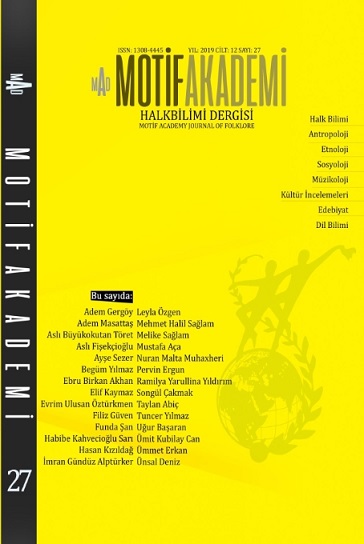DENİZLİ İLİ ÇAL İLÇESİ KABALAR KÖYÜ DÜZ DOKUMA ÖRNEKLERİ
FLAT WEAVING SAMPLES OF KABALAR VILLAGE ÇAL DISTRICT, DENIZLI PROVINCE
Author(s): Habibe Kahvecioğlu SariSubject(s): Cultural history, Customs / Folklore, Ethnohistory, Local History / Microhistory, Cultural Anthropology / Ethnology, Sociology of Culture
Published by: Motif Halk Oyunları Eğitim ve Öğretim Vakfı
Keywords: Denizli; Çal; flat weaving; rug; saddlebag; bag;
Summary/Abstract: Hand weaving has become a part of our cultural identity by developing within the century-old adventure that has started to meet the needs and to protect from the natural conditions by using the materials that people find in their environment. Flat weaving, which has an important place in hand weaving, has been produced for the needs without commercial care, and has been the common memory products reflecting the traditions, customs, feelings and tastes of the weaving community and a weaver. Flat weavings are kilim (rug), cicim (rug woven), zili (sili) and sumac known as downy textiles other than carpets. The Çal district of Denizli province is one of the districts where flat weaving samples are found. In this study, size, material, technique, color and pattern (yanış) names of the flat weaving samples found in Kabalar village of Çal district were intended to be identified and recorded. For this purpose, the region was visited; the rugs, bags, saddlebags and sacks that were found to be weaved in the village were photographed; the data about the weavings were obtained by using the interview method with the individuals who hold these weavings. As a result of the research, it is observed that flat weavings are no longer weaving in the region; the number of individuals who know weaving is gradually decreasing; yarns used in the woven samples are blended with wool and cotton; the names of the pattern (yanış) used in weavings are not remembered by new generations and it has been determined that rugs are named according to their ornaments as “lighter (Çakmacık), four lakes (dört göllü), fractured pattern (kırık yanışlı) ve three wells (üç kuyulu)”.
Journal: Motif Akademi Halkbilimi Dergisi
- Issue Year: 12/2019
- Issue No: 27
- Page Range: 734-748
- Page Count: 15
- Language: Turkish

